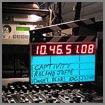 Creating music videos is a delicate process, one that can be easier or harder depending on the images, sequences, and complexities involved. But at its core they are essentially videos shot to sync audio. Here's a workflow that'll keep you from tearing your hair out and make you aware of common novice pratfalls.
Creating music videos is a delicate process, one that can be easier or harder depending on the images, sequences, and complexities involved. But at its core they are essentially videos shot to sync audio. Here's a workflow that'll keep you from tearing your hair out and make you aware of common novice pratfalls.
Thematic Concerns:
Music Videos consist of picture cut to a song. Simple enough definition, but we can expand on this somewhat.
The Music Video can take one of three probable formats: wild (non lip sync) picture cut to music; lip sync performance cut to the music; or a combination of the two.
We see examples of the first style, wild picture cut to the music, commonly in the documentary genre. Often it is a montage of related images including pan/scan of still photos and/or excerpts from film archives. Sometimes the filmmaker will juxtapose a series of images against a familiar song as a way of making a poignant statement, playing emotional images against recognizable lyrics to produce a sum greater than either of its individual parts! For example, the song “When Johnny Comes Marching Home Again” normally conveys Civil War bluecoats or WWI doughboys parading victoriously down Main Street. But replace that cliché with a montage of flag draped coffins being unloaded from a military transport, grieving families, and crying children – and the tune has a totally different impact.
Wild picture cut to music also shows up from time to time in feature film production, again as a montage of transitional images either as backstory exposition or to promote the storyline (and it is not unheard of to include a montage strictly as a vehicle for promoting the song!).
Lip Sync Performance is more of what most people think of when you mention Music Video. A collage of images and angles of the musicians as they appear to perform the song in its entirety. The images may represent a “live performance” on stage, or a “live take” in the recording studio. Sometimes the musicians venture beyond reality, and appear to perform in a myriad of locations and situations, all without missing a beat of their song!
Which brings us to the third style of Music Videos wherein a continuous performance is intercut with non-sync lyrical images to combine into a complex fantasy image. Sometimes we see the musicians performing their song, and other times we are treated to the visual imaginations of the director (which can range from intensely entertaining to childishly moronic).
Novice filmmakers often try to act out the song exactly as it plays. Boring! Redundant!
The most successful Music Videos go beyond merely illustrating the lyrics word for word. The Director strives to relate the images to the song, but at the same time to give ADDED meaning to the original text. More than likely, the viewer/listener is already familiar with the song, having heard it countless times on the radio or the Ipod. To spark renewed interest in the music, a good Director is able to present the lyrics in a new perspective with some deeper significance; or at least in a refreshingly entertaining visual tour de force.
It is extremely important to note that Performance sections are always shot to pre-recorded audio playback. This is done because it is impossible for even the finest musicians to repeat their live renditions precisely enough to allow various takes to be linked together without skipping a beat, nor altering tempo, nor changing pitch, etc. Repeatable playback is essential if we expect to shoot multiple takes, multiple angles, and possibly even spread those takes over multiple locations/times.
Even the so-called “live concert performances” are done by recording the first take (shot live multi-camera) and then playing back that first performance track in order to shoot additional angles or takes.
